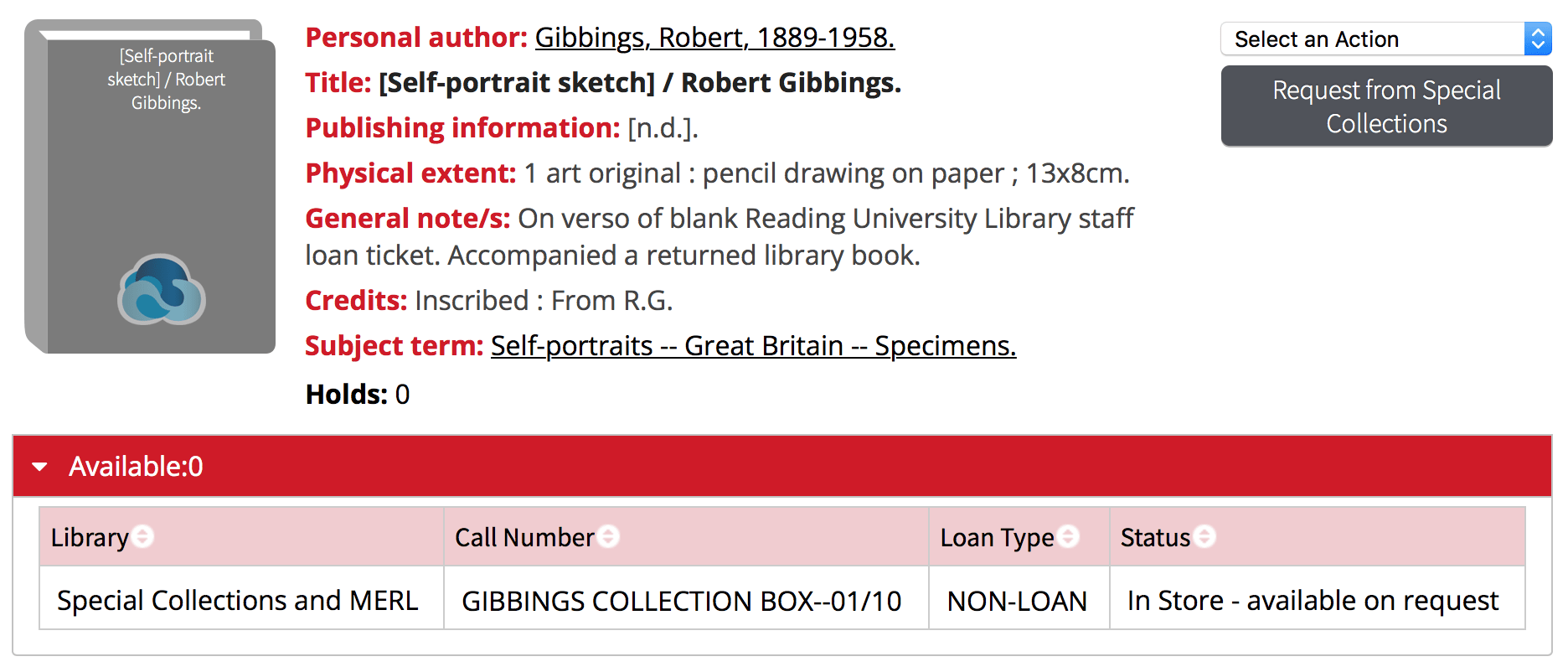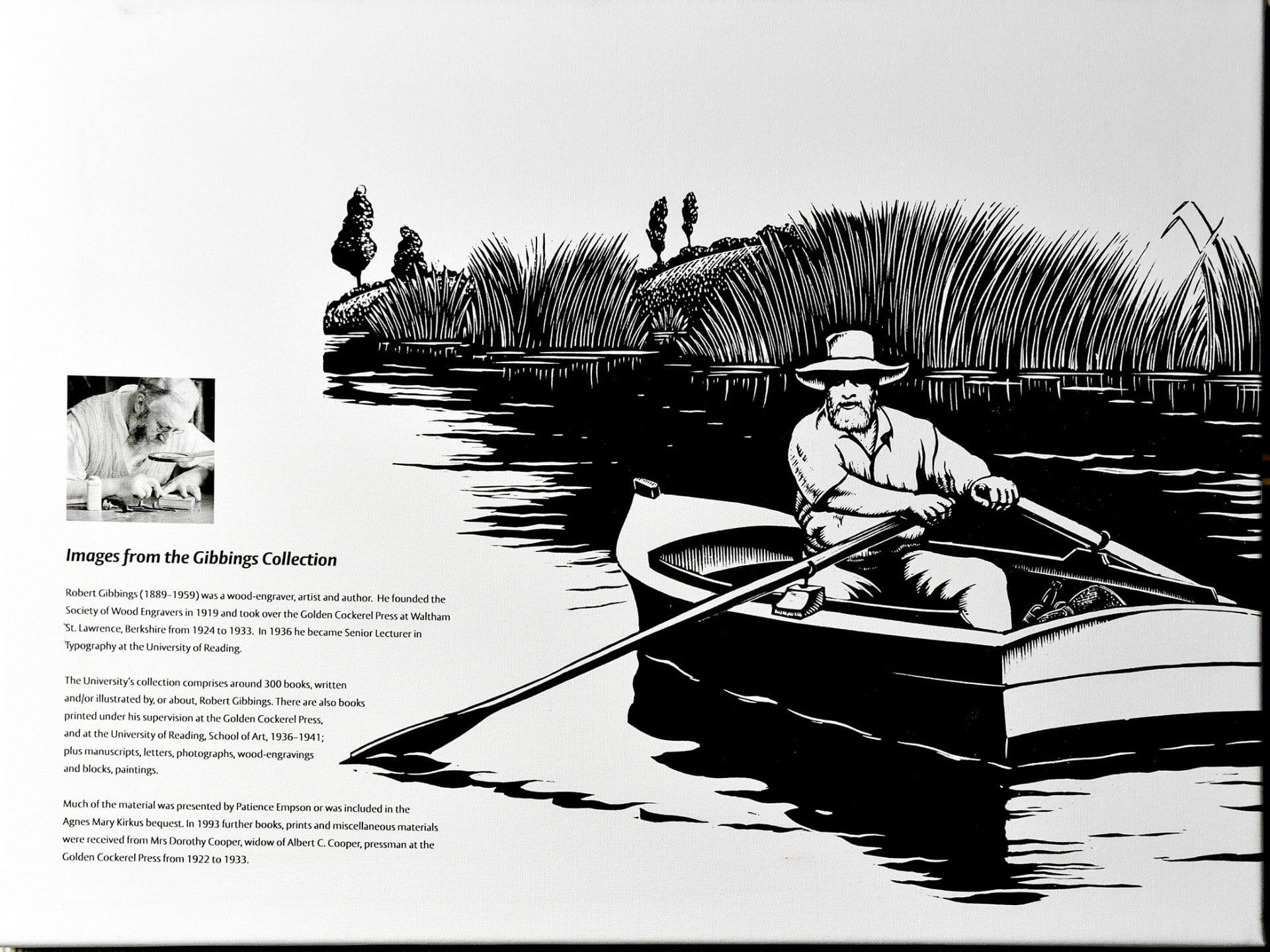The artist Robert Gibbings accepted the post of Sessional Lecturer in Typography and Book Production at Reading University’s School of Art in 1936. He stayed until some time during the academic year of 1942-43.
I was searching the Enterprise Catalogue for one of Gibbings’s travel books when I came across an unusual entry – a self-portrait in the University’s Special Collections that had ‘Accompanied a returned library book’.

During Gibbings’s time at Reading, the University Library was located in what is now the Architecture Building (L46) on the London Road Campus. Staff loans were recorded on ‘tickets’ that had to be filled in by the borrower.

It appears that Gibbings had quickly sketched a self-portrait on the back of one of these and handed it in with the book he was returning.

I knew little about Robert Gibbings, but I was aware of the eight wood engravings of river life, birds and plants, that are on display in the ground-floor corridor of Acacias at London Road. The first of these, on the right as one enters from the foyer and walks towards the Common Room, is another self-portrait showing him rowing on the River Seine.

Martin Andrews, Gibbings’s biographer, dates the original engraving as circa 1951 (Andrews, 2003, p.328) . In this reproduction it has been supplemented by biographical notes, information about the Gibbings Collection, and a photograph of Gibbings at work.

Robert Gibbings at the University of Reading
Although the image above claims that Gibbings was appointed Senior Lecturer in 1936, I can find no evidence of this level of seniority in the University Calendars or Annual Reports. They show that he was recruited as a sessional tutor to the School of Art by Professor Betts in 1936, but was not awarded a full Lectureship until the following year. There is no mention of further promotion.
In the preface to a collection of his engravings edited by Patience Empson, Gibbings describes his time at the University:
‘They had invited me to teach wood engraving in their art school and I, on the understanding that I might teach with one eye always cocked on typography, had accepted. There was time for thought even in term time, and there were long vacations, and both suited me well.’ (Empson, 1959, p. xliii)
Those long vacations were put to good use for trips to Bermuda and the Red Sea. He claimed to have travelled over 50,000 miles over the oceans before exploring his beloved River Thames and other favourite rivers in his ‘home-made’ flat bottomed boat. The latter, named ‘The Willow’, was built in the woodwork section of the School of Art by Gibbings’s colleagues Hubert Davis and Norman Howard, with Gibbings and his son Patrick as ‘unskilled assistants’ (Gibbings, 1941, p. x).
Gibbings was obviously a popular figure at Reading:
‘Everybody knew Gibbings and Gibbings talked to everybody, or played bowls with them or lured them into exercise with the medicine ball, for he was a mountain of a man.’ (Holt, 1977, p. 99)
Underwater Art
Gibbings was multi-talented as an engraver, sculptor, printer and publisher. He was also a naturalist, travel writer and broadcaster (this video from British Pathé titled ‘Robert Gibbings Artist (1945)’ shows him at work at home and by the Thames).
Less well known, however, is his pioneering work as an underwater artist. By the end of the 1930s he had already developed an extensive knowledge of marine life but became dissatisfied with making inferior depictions of dead specimens, or fish swimming about in a container:
‘… it was my ambition to get on closer terms with the fish, and to meet them on their own level … to make drawings under the water’ (Gibbings, 1938, p.32).
The main technical problems were finding a drawing surface that would accept pencil marks under the sea, constructing some kind of breathing apparatus and manoeuvring safely around the seabed. These and their solutions are described in Gibbings’s Pelican Special paperback ‘Blue Angels and Whales’ (1938).
The first solution was provided by his colleague Cyril Pearce, Lecturer in Design and Composition:
‘… he suggested that I should try working on sheets of xylonite, a waterproof substance not unlike celluloid, which when roughened with sandpaper takes a pencil as pleasantly as paper. I had therefore brought a supply of this material with me [to Bermuda], as well as some thick sticks of graphite, which are usually supplied as refills for sketching pencils, but instead of their normal wooden casing, which would have come to pieces in the water, fitted them into rubber tubing, so that my hands would remain clean and smudges on the drawings be avoided.’ (Gibbings, 1938, pp. 32-3).
The solution to the breathing issue took the form of a rectangular metal helmet which, far from being watertight, was open at the bottom. A hose at the top of the helmet connected to a pump on the accompanying boat. The pump provided sufficient air pressure to prevent the helmet from filling with water, excess air escaping from the bottom of the helmet around his shoulders. This arrangement enabled him to breathe easily.
The third problem remained, however; even thought the weight of the helmet reduced buoyancy, he was unable to keep his footing at 20 feet below the surface. Eventually, the addition of 20 pounds of lead piping and, later, 12 yards of anchor chain round his waist solved this problem too and Gibbings was able to spend periods of 15 to 20 minutes making accurate sketches that could be fleshed out on dry land.
Examples of Gibbings’s underwaterscapes can be found on the website of Iconic Edinburgh.
Sources
Andrews, M. J. (2003). The life and work of Robert Gibbings. Bicester: Primrose Hill Press.
Empson, P. (Ed.) (1959). The wood engravings of Robert Gibbings with some recollections by the artist. London: J. M. Dent.
Garrett, A. (1980). British wood engraving of the 20th Century: a personal view. London: Scholar Press.
Gibbings, R. (1938). Blue angels and whales: a record of personal experiences below and above water. Harmondsworth: Penguin.
Gibbings, R. (1941). Sweet Thames run softly. London: Readers Union Limited.
Gibbings, R. (1953). Coming down the Seine. London : J. M. Dent & Sons Ltd.
Holt, J. C. (1977). The University of Reading: the first fifty years. Reading: University of Reading Press.
University of Reading. Calendar, 1936-37 to 1942-43.
University of Reading. Proceedings of the University, 1937-38, 1942-43.
Walker, S. & Andrews, M. (1974). Robert Gibbings and the ‘Willow’. University of Reading.
